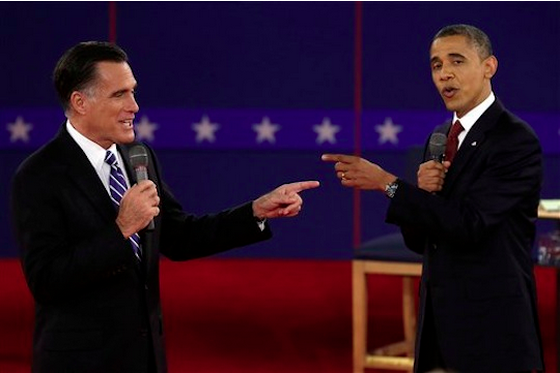 Talking past each other Republican presidential nominee Mitt Romney and President Barack Obama spar during the second 2012 presidential debate. (AP Photo/Charlie Neibergall)
Talking past each other Republican presidential nominee Mitt Romney and President Barack Obama spar during the second 2012 presidential debate. (AP Photo/Charlie Neibergall)
A month before the first 2012 presidential debate, widely considered a decisive victory for Republican candidate Mitt Romney, GOP campaign staffers began conducting dry runs of their debate-night social media use. Romney’s digital team put together a 90-page dossier of research to reinforce his arguments, also crafting around 200 infographics that could be shared during the contest.
That preparation helped the Romney team shape a favorable media narrative as the debate unfolded in real time. Political reporters began declaring a Republican victory long before the candidates left the stage. “The social got so overwhelming [team Obama] didn’t even turn up for 30 minutes after the debate” so they could regroup, Zac Moffatt, Romney’s digital director, said later.
This is the reality of political communications today, according to a study published last week by University of North Carolina researcher Daniel Kreiss, who interviewed operatives from both candidates’ digital teams for his analysis.
Communications staffers’ goals are shifting away from winning individual 24-hour news cycles, Kreiss told me by phone Monday, and toward domination of shorter windows of time on social media, especially Twitter. Staffers he interviewed described how well-timed and contextually appropriate tweets could manipulate “how journalists saw and understood the political context and the frames they used in their coverage.” Covering live events on Twitter presents inherent difficulties for political reporters, as I wrote in July. And the narrative that takes shape there often spills over into subsequent versions of coverage, Kreiss added, first in quick takes immediately following live events and eventually in day-after stories.
“Journalists need to be aware that what shows up in their Twitter feeds is shaped by these strategic communications,” said Kreiss, an assistant professor who studies political communications. This comes as Twitter has begun replacing the campaign bus or bar as the setting where media narratives develop, not only because it allows journalists to rub digital shoulders, but also because many reporters use the medium as a rough gauge of public opinion.
“What Twitter is actually reflecting is an insider-baseball phenomenon,” he said. “There’s this loop between journalists and politicos, and they’re all part of this insider conversation. And that’s what [journalists] are reporting back on.”
Obama’s digital team, outmatched in the first presidential debate, had a more aggressive strategy for the second contest, according to the report. Staffers drafted hundreds of tweets to be sent from the accounts of Obama or senior campaign officials, aggregating additional content to rebut Romney’s claims. Flooding the zone with positive Twitter spin would pay dividends regardless of the president’s performance, Teddy Goff, Obama’s digital director, told Kreiss.
…no matter what was going on, frankly whether or not the president did his job, you know, there would be very loud voices talking about how we were doing well so that if we were doing well that would be perfectly clear to reporters and if we weren’t doing that well they would look at Twitter and see that it was a lot more mixed than they expected and sort of second guess their own perception that maybe the president wasn’t doing that well.
The study received more than its fair share of attention after it was published online Friday. And perhaps proving the undercurrent of Kreiss’ work — that media narratives often take shape on Twitter — nearly all of the subsequent coverage reflected an observation by former CJR and current New York Times contributor Brendan Nyhan.
Management expert Mitt Romney had 22 people approving every tweet – new @kreissdaniel article https://t.co/VH7yH9CKkB pic.twitter.com/o4upeyHDu2
— Brendan Nyhan (@BrendanNyhan) December 5, 2014
Indeed, a 22-person approval process seems overly Byzantine for a platform like Twitter. The Washington Post (twice), The New York Times, USA Today, MSNBC, Talking Points Memo, Slate, Politico, and others led with that tidbit in their writeups, which often portrayed the Romney team as out-of-touch with modern technology. But that fixation, as noted by Middlebury College political science professor Matthew Dickinson, belies the effectiveness of the Romney campaign’s social media strategy, which was in fact noted by the report.
It is evident that many pundits, reacting to the pressure of publishing in the compressed media cycle that characterizes the digital age, did not bother to read the Kreiss article closely and instead simply relayed the initial twitter excerpt that fit with the prevailing conventional wisdom regarding how the data-driven, digital-savvy Obama campaign ran circles around poor Mitt’s antiquated analog-based outfit.
Topsy analytics show “Romney” and “22” appeared in more than 3,200 tweets over the past four days, many of them by influential journalists and liberals with large social media followings. “Yeah,” Kreiss added by phone, “it is a bit ironic.”
David Uberti is a writer in New York. He was previously a media reporter for Gizmodo Media Group and a staff writer for CJR. Follow him on Twitter @DavidUberti.
